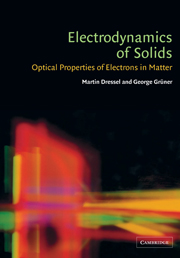13 - Semiconductors
Published online by Cambridge University Press: 20 May 2010
Summary
Optical experiments on semiconductors have led to some of the most powerful confirmations of the one-electron theory of solids; these experiments provide ample evidence for direct and indirect gaps, and in addition for excitonic states. Optical studies have also contributed much to our current understanding of doping semiconductors, including the existence and properties of impurity states and the nature of metal–insulator transitions which occur by increasing the dopant concentration. Experiments on amorphous semiconductors highlight the essential differences between the crystalline and the amorphous solid state, and the effects associated with the loss of lattice periodicity. We first focus on experiments performed on pure band semiconductors for which the one-electron theory applies, where direct and indirect transitions and also forbidden transitions are observed; in these materials the subtleties of band structure have also been explored by experimentation. This is followed by examples of the optical effects associated with exciton and impurity states. Subsequently we consider the effects of electron–electron and electron–lattice interactions, and finally we discuss optical experiments on amorphous semiconductors, i.e. on materials for which band theory obviously does not apply.
Band semiconductors
The term band semiconductor refers to materials where the non-conducting state is brought about by the interaction of electrons with the periodic underlying lattice. Single-particle effects – accounted for by band structure calculations – are responsible for the optical properties under such circumstances, these properties reflecting interband transitions.
- Type
- Chapter
- Information
- Electrodynamics of SolidsOptical Properties of Electrons in Matter, pp. 339 - 370Publisher: Cambridge University PressPrint publication year: 2002



